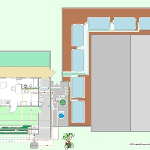
Off-grid Demo Tiny Home & Shop with Rain+Snow Cisterns for Food Crop Terracing by Tiny Home Off-grid
 Maryette Haggerty Perrault May 2, 2015 06:07 |
Hello! Thanks for starting a proposal! It certainly seems like you have quite a list of ideas to mitigate climate change incorporated into this proposal for a tiny house. I would ask you to elaborate on how you see this structure impacting climate change and building design on a larger scale. Do you see this building serving as a case study for future development or is it to serve as the first of many tiny homes built to the same specification?
You mention that the house is designed for cooler climates with roughly 6,600 HDDs - how easily do you see these design features translating to different climates? I am sure building efficiency will play a key role in allowing wind turbines to generate all electricity consumed onsite, so what sorts of building materials will be used to enable this structure to be net zero? What sort of energy storage would be used to prevent intermittent power supply from the wind turbines?
I look forward to reading more about your ideas!
|
 Tom Mallard May 2, 2015 07:11 | Proposal contributor
Forgive my not adding more to this yet, doing a startup so have a lot of content on this, design sketches to scale to lumber lists.
A number on trick is an inexpensive thermal-mass to store heat or cold daily, it's really the big deal don't tell.
I helped design & build passive solar in the 80's so have a feel for how we did it wrong, this can fit in a crawl space or added as a deck and hooked up to the best section of roof for most people.
With an existing home the method is to take the heat-loss worst-case to design the mass volume to, so, it's precise vs the 80's.
Second trick with the tiny demo, the solar panels are mounted like greenhouse glazing, weatherproof and over a thin air-tight box, it's the air collector ducted to the thermal-mass so leverages the panels for air heating, they get hot-cold daily.
I'm buying the water system from Earthship made-to-order saves time & stress they pass code & work well. I have a vendor for large capacity battery-inverter systems, mini-grid specific 1-5Mwh small town scale the focus for me small windmills, more on that.
For the shop & home I can fire a kiln after dark using 32kwh of 360vdc and that's about a huge house for size another reason to pick it.
So the big deal is that it passes code being off-grid, the lot has no sewer or well so it may be looked upon with favor.
Then, a final R&D of mine is home-ranch-farm scale photo-bioreactor units that grow algae from the septic tank effluent & a small biodiesel machine to make a biofuel from sewage at the home.
For a dairy the barn washdown will likely power all the field equipment and heat the barns doing this, it's the last step, I have a small wastewater & power utility willing to help do the cerification as a pure water source the end goal and have researched it for 9-years starting in labs in Phoenix, AZ, where the people at the plants helped out as well.
They like that the units are semi-portable so can help with onsite remediation of farm spills, not uncommon.
That's the scope of the project, will try to get the forms done this coming week.
For the lot, it's very windy, gusty to 35-knots. The panels & greenhouse give full headroom to the second floor so adding a 6ft wide deck, enclose that with glazing set at 45-degrees not to get slammed by gusts to a 4ft high hemp-mortar wall to help insulate the enclosed "porch".
Two sides of this have soil-contact foam under the dirt for starts and indoor greens, the greenhouse has perennials for greywater cleaning so usually only citrus or banana trees the only food the rest are to extract nutrients for the water to flush the toilet with.
With the glazings at 45° it lets a lot of sun in most of the year in the afternoon to heat it directly and has ducting under the dirt to warm it from below like the thermal-mass. This looked feasible to not need heating often, dry side of the Cascades so good solar gain on the panels.
Finally, for windmills search on Prof. John Dabiri, a Caltech prof that ran 5-years of field trials proving that smaller vertical-axis windmills can generate 10-times more per acre than big ones, can write a whole paper on that but have specific VAWT designs now leverage his principles.
Cheers, tom
|
 Cristina Miclea May 17, 2015 01:45 |
Hi Tom,
Thank you for developing this proposal. We look forward to seeing it updated over the next couple of weeks!
|
 Vishal Bhavsar Jun 7, 2015 09:12 |
Hello Tom,
This is well researched proposal put out with fully integrated solutions. I would like to see you this project can be scalable to different geographies and climatic zone.
I would also like to see cost and timeline built into the proposal.
Look forward for the final bits of addition to your proposal.
All the best!
Regards,
Vishal
|
 Tom Mallard Jun 26, 2015 01:33 | Proposal contributor
Vishal, when I printed out the proposal just before the deadline it's a draft ...
However, one of the new things is the Moray pit terracing for cash-crop farming on dryland techniques of only using rainfall & snow.
This is the image with to-scale terraces 1m wide: that hold an acre-foot of water.
http://www.mallard-design.com/mdc2010/media/tiny/site-terrace-plot-color-b.jpg
|
 Tom Mallard Jun 26, 2015 01:59 | Proposal contributor
Missed posting the thermal-mass diagram with design properties ... http://mallard-design.com/mdc2010/media/bladder-mass.jpg
|